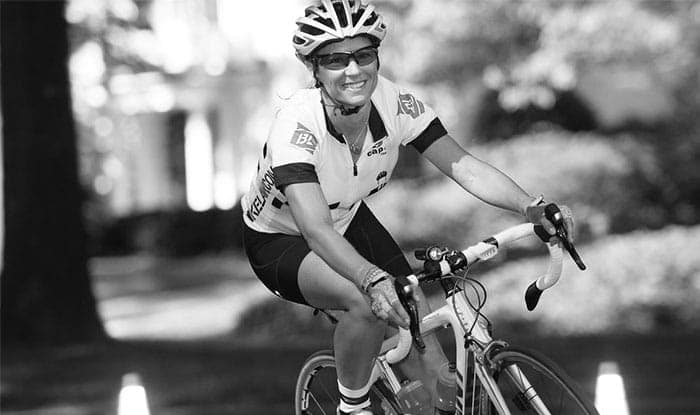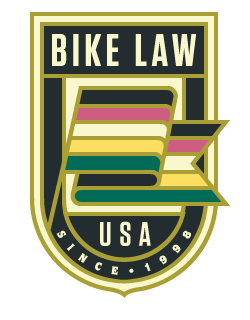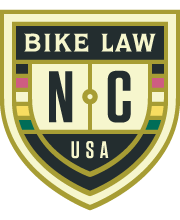Bike Law North Carolina, Ann Groninger, has been protecting bicyclists for over 15 years and has written the book on North Carolina bicycle laws.
Representation in North Carolina Bicycle Crash Cases
North Carolina’s varied geography and year-round riding climate make for ideal bicycling conditions. The fall and spring are especially pleasant times for cycling on the state’s network of quiet rural roads. You’ll find challenging hills in the Blue Ridge Mountains, rolling terrain in the Piedmont and hundreds of miles of flat coastal plain riding in the eastern part of the state.
Unfortunately, bicyclists in North Carolina face some of the country’s most archaic and unfair laws, including the antiquated contributory negligence doctrine. Also, rapid urbanization and the resulting suburban sprawl in several cities have put traffic pressure on old farm-to-market roads and increased the level of hostility toward bicyclists.
*** JANUARY 2020 ***
Ann’s classic, must-read Ride Guide has been updated in a Second Edition for 2020!
NC Ride Guide 2020Ann Groninger


North Carolina lawyer and Bike Law founder, Ann Groninger, has advocated at the state level on behalf of bicyclists in North Carolina for over 15 years.
Ann wrote the book on North Carolina bicycle laws. It’s called the “Ride Guide (BLB #1: North Carolina Bicycle Laws).”
Ann has offices in Charlotte and Durham and has helped bike accident clients in Asheville, Raleigh, Durham, Greenville, Wilmington, Fayetteville, and throughout the state. Read more about Ann on her bio page.
North Carolina Bicycle Laws
Right to the Road
- North Carolina bicyclists generally have the same rights, and same duties, as drivers of motor vehicles
Prohibitions
- Unsanctioned bicycle racing is prohibited
Helmets
- Helmets are required for children under 16
Alcohol
- North Carolina’s DWI statute DOES apply to bicyclists
Report Your North Carolina Bike Accident
If you have been in a bike-car crash anywhere in North Carolina, we are here to help. We've handled dozens of bike accident claims. To get started, please complete our Bike Accident Report Form and we'll contact you as soon as possible. All we need is your name, e-mail, phone number, and a few details about the circumstances of your crash.
Cycling In Raleigh, Durham, and Charlotte
Bike Law features pages on biking in Raleigh, Durham, and Charlotte.
- Charlotte: Charlotte has an active bicycling population and is moving forward with a progressive plan to accommodate bicyclists on and off the road. Biking infrastructure includes signed bike routes and painted bike lanes and bike boxes. A significant challenge that cyclists face is Charlotte’s rapid growth and suburban sprawl – an average of 44 new residents move there every day – and that puts pressure on the city’s infrastructure.
- Durham: Durham is earning a reputation as a bicycling destination and was recently compared favorably to the biking mecca of Portland, Oregon. Yet, local bicycling advocates say there is still much work to do. Highlights of biking in Durham include the 22-mile American Tobacco Trail which connects downtown Durham to neighborhoods and counties to the south.
- Raleigh: Raleigh's updated Comprehensive Bicycle Plan calls for 440 miles of new biking facilities, up from three stretches of bike lanes just a decade ago. Like other North Carolina cities, Raleigh is growing rapidly, and suburban sprawl is putting pressure on roads near the city’s edges. Raleigh has an extensive greenway network, including a 27-mile trail along the Neuse River.
City, Statewide Biking Maps
Besides the cities listed above, other North Carolina cities with major biking networks include Asheville, Wilmington, Cary, High Point, Winston-Salem, Greensboro, and Carrboro / Chapel Hill.
North Carolina also has an extensive statewide cycling network. Nine different routes covering 3,000 miles have been designated by the state DOT’s Division of Bicycle and Pedestrian Transportation. According to the DOT website, “These routes generally parallel the major highways along which cyclists often wish to travel, but offer a more lightly traveled alternative than the busy, major roads that are familiar to most people.” Routes include:
- Carolina Connection—US Bike Route 1: Designated as a portion of US Bike Route 1, this route covers almost 200 miles of rolling terrain and is the main north/south connector route through the central portion of North Carolina.
- Mountains to Sea—NC Bike Route 2: Bike Route 2 is a challenging 700-mile route from the mountain town of Murphy in the western corner of the state to the coastal town of Manteo.
- Ports of Call—NC Bike Route 3: This 300-mile north-south route from Virginia to South Carolina passes through several historic port cities, including Edenton, Bath, New Bern, Wilmington, and Southport.
- North Line Trace—NC Bike Route 4: This 400-mile east-west route runs along North Carolina’s border with Virginia from the mountains to the coast, passing near or through Eden, Roxboro, Henderson, Roanoke Rapids, and Elizabeth City.
- Cape Fear Run—NC Bike Route 5: This 160-mile route runs parallel to the Cape Fear River in the coastal plain.
- Piedmont Spur—NC Bike Route 6: This 200-mile route is a southern alternative to the increasingly urban Piedmont portion of the Mountains to Sea route. It passes through Morganton, Lincolnton, several Charlotte suburbs and Albemarle, ending near Snow Camp.
- Ocracoke Option – NC Bike Route 7: This 170-mile route picks up from Bike Route 2 near Wilson and winds through the coastal plain to the Cedar Island Ferry over to Ocracoke. Towns on or near the route include Wilson, Goldsboro, Kinston, and New Bern.
- Southern Highlands—NC Bike Route 8: This 120-mile route passes through several mountain towns, including Brevard, Saluda, Flat Rock, Tryon, and Forest City before ending at the NC 6 Piedmont Spur in Lincolnton.
- Sandhills Sector—Bike Route 9: This 125-mile route features rolling terrain and passes near Pinehurst, Southern Pines and south of Fayetteville. It connects with the NC 6 Piedmont Spur near Albemarle and ends near the Cape Fear River at NC 5 Cape Fear Run.
North Carolina Bike Crash Statistics
Each year an average of 960 bicyclists are hit by vehicles in North Carolina, making it one of the least safe states in the U.S. for bicycling. On average, about 20 bicyclists are killed each year in North Carolina, according to WatchForMeNC.com.
North Carolina ranked 10th in deaths per million, at 2.59 in 2011, putting it among the nation’s top 10 “most dangerous states for cyclists,” according to a 2014 article in the Asheville Citizen-Times. The article cited an Insurance Business America website report and DOT data. The state has only shown a slight improvement since then. That fatality rate had fallen to 2.23 per million – or 14th worst of all states, according to a May 2015 NHTSA report, which reported on statistics for 2013, when 22 cyclists were killed.
North Carolina Bike Law Speakers
If you would like Bike Law to come speak to your club or at your shop, please contact us.
Please be advised that this website is for the purpose of legal advertising and marketing.





